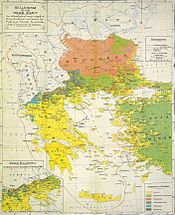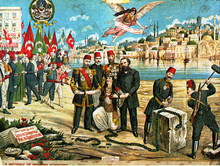Ottoman Greeks

The Ottoman Greeks ( Greek Οθωμανοί Έλληνες , Turkish Osmanlı Rumları ) were ethnic Greeks who lived in the Ottoman Empire (1299–1923), the predecessor of the Republic of Turkey . Ottoman Greeks, who were Orthodox Christians, belonged to the Rum-Millet ( Millet-i Rum ); This millet also included the Pontic Greeks , who were forcibly expelled from Turkey today, and the caramans . The latter are Greek Orthodox, but speak or spoke Turkish. Their ethnic origin is unclear.
With the ethnic cleansing of the Pontic Greeks and the bloody expulsion of the surviving Greeks from 1914 to 1923, the once flourishing Greek life from the Ottoman Empire almost no longer existed in today's Turkey.
history
Legal status

In the Ottoman Empire, the Greek Christians were hindered in their religious practice in accordance with the Islamic dhimmi system, and the Greeks were treated as second class people. Christians and Jews were not as the Muslims considered equal: witness statements against Muslims by Christians and Jews were inadmissible in court. They were forbidden to own weapons or ride horses, their houses were not allowed to tower over those of the Muslims, and their religious practices were allowed to be as inconspicuous as possible, in addition to several other legal restrictions. Violations of these statutes could result in harsh punishments, ranging from collecting fines to executions.
The Greek Ecumenical Patriarch was recognized as the highest religious and political authority (millet-baschi or ethnarch) of all Orthodox Christian subjects of the Sultan, although at certain periods some regional powers, such as Russia (under the Treaty of Küçük Kaynarca 1774), or Great Britain the right claimed protection over the Orthodox subjects of the Ottoman Empire.
19th century
After the uprising of the Greeks against the Ottoman Empire in 1821 , but especially after the recognition of independence from Greece after the London Conference of 1832, the mood towards the Greek population in the Ottoman Empire had largely deteriorated. Nationalist ideas found more and more supporters also among the Turkish population in the multi-ethnic state of the Ottomans. Coexistence became more and more difficult over time and the collapse of the empire.
The three great European powers, Great Britain, France and Russia (known as Great Powers), disagreed with the Ottoman Empire's treatment of Christian minorities and put increasing pressure on the Ottoman government (also known as the Sublime Porte ) for equal rights expand all of their citizens. Beginning in 1839, the Ottoman government introduced the Tanzimat reforms in the wake of Ottomanism to improve the situation of the minorities, although these proved to be largely ineffective. In 1856, the Hatt-ı Hümâyûn Edict promised equality for all Ottoman citizens regardless of their ethnicity or denomination, and expanded the scope of the Hatt-ı Şerif 1839 Edict of Gülhane Park . The reformist period led to the constitution, the Kanun-ı Esasi ( Ottoman Constitution ), written by members of the Young Ottomans , and published on 23 November 1876. It established freedom of religion and equality of all citizens before the law - but this was hardly implemented.
20th century
On July 24, 1908, there was more hope for the Greeks when Sultan Abdülhamid II (r. 1876-1909) was deposed and the constitution, which he had repealed years earlier, came into force again. The Committee for Unity and Progress (commonly known as the Young Turks ), a political party in opposition to the absolute rule of Sultan Abdülhamid II, had launched a rebellion against its ruler. Finally, the pro-reform Young Turks deposed the Sultan and replaced him with Sultan Mehmed V (r. 1908-1918).
Before World War I, there were an estimated 1.8 million Greeks living in the Ottoman Empire. Some prominent Ottoman Greeks served as Ottoman MPs. There were twenty-six Ottoman-Greek MPs in the 1908 parliament, but their number dropped to eight by 1914.
During the First World War and the Greco-Turkish War between 1914 and 1923, Greeks in Thrace and Asia Minor were victims of a campaign of extermination, including massacres such as the Smyrna fire and internal displacement with death marches . The International Association of Genocide Researchers (IAGS) recognizes this as genocide and describes the campaigns as "Genocide of the Pontic Greeks".
Patriarchy
After the fall of Constantinople in 1453, when the Sultan virtually replaced the Byzantine Emperor , the Ecumenical Patriarchate of Constantinople was taken over by the Sultan as the religious and national leader of the Greeks and the other ethnic groups that became the Greek Orthodox Millet among the now subordinate and oppressed Christians were included. The patriarchy was of the utmost importance and played the key role among the Christians of the Ottoman Empire, as the Ottomans did not legally differentiate between nationality and religion and therefore regarded all Orthodox Christians of the empire as a unit.
The position of the patriarchate in the Ottoman state promoted the Greek Revival projects , focused on the resurrection and revival of the Byzantine Empire . The patriarch and the ecclesiastical dignitaries around him formed the first center of power for Greeks in the Ottoman state, although their structures were infiltrated by the Ottoman state while they themselves attracted the Byzantine nobility.
identity
The Greeks were a confident group within the larger Orthodox Christian community established by the Ottoman Empire. They differentiated themselves from their Orthodox fellow believers in maintaining their Greek culture, customs, language, and educational traditions. Over the entire post-Byzantine and Ottoman period to himself designated Greeks, as members of the Ecumenical Patriarchate of Constantinople Opel, as Graikoi (Greek Γραικοί, "Greeks") and Romaioi or Romioi (Greek Ρωμαίοι / Ρωμηιοί, " Rhomäer ", Turkish Rum ). They played an important role in the economy and rose in civil service. As diplomats, they formed a link to Europe. There were Greek communities in every major Ottoman city.
Well-known Ottoman Greeks
- Aleksandro Karatodori (1833–1906)
- Basil Zaharoff (1849-1936)
- Christakis Zografos (1820–1896), banker and benefactor
- Elia Kazan (1909-2003)
- Elias Venezis (1904–1973), writer from Ayvalık
- Emanuel Emanuelides , Ottoman MP
- Evangelinos Misailides (1820–1890)
- Ibrahim Pasha , Grand Vizier of Suleyman the Magnificent
- Ishak Pasha , Grand Vizier
- Kösem Mahpeyker Sultan (1589–1651), wife and mother of several sultans, regent
- Nikolas Mavrokordatos (1680-1730)
- Prince Alexandros Mavrokordatos (1791–1865)
- Yorgo Zarifi (1810–1884), banker and financier
gallery
Declaration of the constitution ; Muslim, Greek and Armenian leaders together
See also
literature
- Taner Akçam : A Shameful Act. The Armenian Genocide and the Question of Turkish Responsibility . Metropolitan Books, New York NY 2006, ISBN 0-8050-7932-7 .
- Louis-Paul Alaux, René Puaux: Le Déclin de l'Hellénisme. Librairie Payot & Cie, Paris, France 1916.
- Spyros I. Asdrachas: An Introduction to Greek Economic History, Fifteenth to Nineteenth Centuries: Fields of Observation and Methodological Issues. In: The Historical Review , Volume 2, 2005, ISSN 1790-3572 , pp. 7-30, digitized version (PDF; 133 kB) .
- Robert Bator, Chris Rothero: Daily Life in Ancient and Modern Istanbul. Runestone Press, Minneapolis MN 2000, ISBN 0-8225-3217-4 .
- Thomas Harrison (Ed.): Greeks and Barbarians. Routledge, New York NY 2002, ISBN 0-415-93958-5 .
- Charles Hopf : Chroniques gréco-romanes inédites ou peu connues. Weidmann, Berlin 1873, digitized .
- George Kakavas: Post-Byzantium. The Greek Renaissance. 15th – 18th Century Treasures from the Byzantine & Christian Museum, Athens . Hellenic Ministry of Culture - Byzantine & Christian Museum, Athens 2002, ISBN 960-214-053-4 .
- Victor Roudometof, Roland Robertson: Nationalism, Globalization, and Orthodoxy. The Social Origins of Ethnic Conflict in the Balkans. (= Contributions to the Study of World History , Volume 89). Greenwood Press, Westport CT et al. a. 2001, ISBN 0-313-31949-9 .
- Vamık D. Volkan, Norman Itzkowitz: Turks and Greeks. Neighbors in Conflict. Eothen Press, Huntingdon 1994, ISBN 0-906719-25-9 .
- Dimitri Gondicas, Charles Issawi (Ed.): Ottoman Greeks in the Age of Nationalism. Politics, Economy, and Society in the Nineteenth Century. Darwin Press, Princeton NJ 1999, ISBN 0-87850-096-0 .
- Richard Clogg : I Kath'imas Anatoli. Studies in Ottoman Greek History (= Analecta Isisiana , Volume 77). Isis Press, Istanbul 2004, ISBN 975-428-274-9 .
Individual evidence
- ↑ Akçam: A Shameful Act. 2006, p. 24.
- ↑ Alaux, Puaux: Le Déclin de l'Hellénisme. 1916.
- ^ Roudometof, Robertson: Nationalism, Globalization, and Orthodoxy. 2001, p. 91.
- ^ Genocide Scholars Association Officially Recognizes Assyrian, Greek Genocides (PDF) International Association of Genocide Scholars. December 16, 2001. Archived from the original on June 1, 2011. Retrieved May 30, 2015.
- ↑ a b Harrison (Ed.): Greeks and Barbarians. 2002, pp. 276-277: “ The Greeks belonged to the community of the Orthodox subjects of the Sultan. But within that larger unity they formed a self-conscious group marked off from their fellow Orthodox by language and culture and by a tradition of education never entirely interrupted, which maintained their Greek identity. ”
- ↑ Volkan, Itzkowitz: Turks and Greeks. 1994: “ While living as a millet under the Ottoman Empire they retained their own religion, customs, and language, and the 'Greeks became the most important non-Turkish element in the Ottoman Empire'. ”
- ↑ Kakavas: Post-Byzantium. 2002, p. 29: “ All the peoples belonging to the flock of the Ecumenical Patriarchate declared themselves Graikoi (Greeks) or Romaioi (Romans - Rums). ”
- ↑ Asdrachas: An Introduction to Greek Economic History, Fifteenth to Nineteenth Centuries: Fields of Observation and Methodological Issues. In: The Historical Review , Volume 2, 2005, pp. 7-30, here p. 8: “ The people we have named as Greeks ( Hellenes in the Greek language) would not describe themselves as such - they are generally known as Romioi and Graikoi - but according to their context the meaning of these words broadens to include or exclude population groups of another language and, at the same time, ethnicity. ”
- ↑ Epistola Theodori Zygomalae. In: Hopf: Chroniques gréco-romanes inédites ou peu connues. 1873, p. 236: "... ησάν ποτε κύριοι Αθηνών, και ενωτίζοντο, ότι η νέων Ρωμαίων είτε Γρασικών βαίσιλεί ασικ ...



